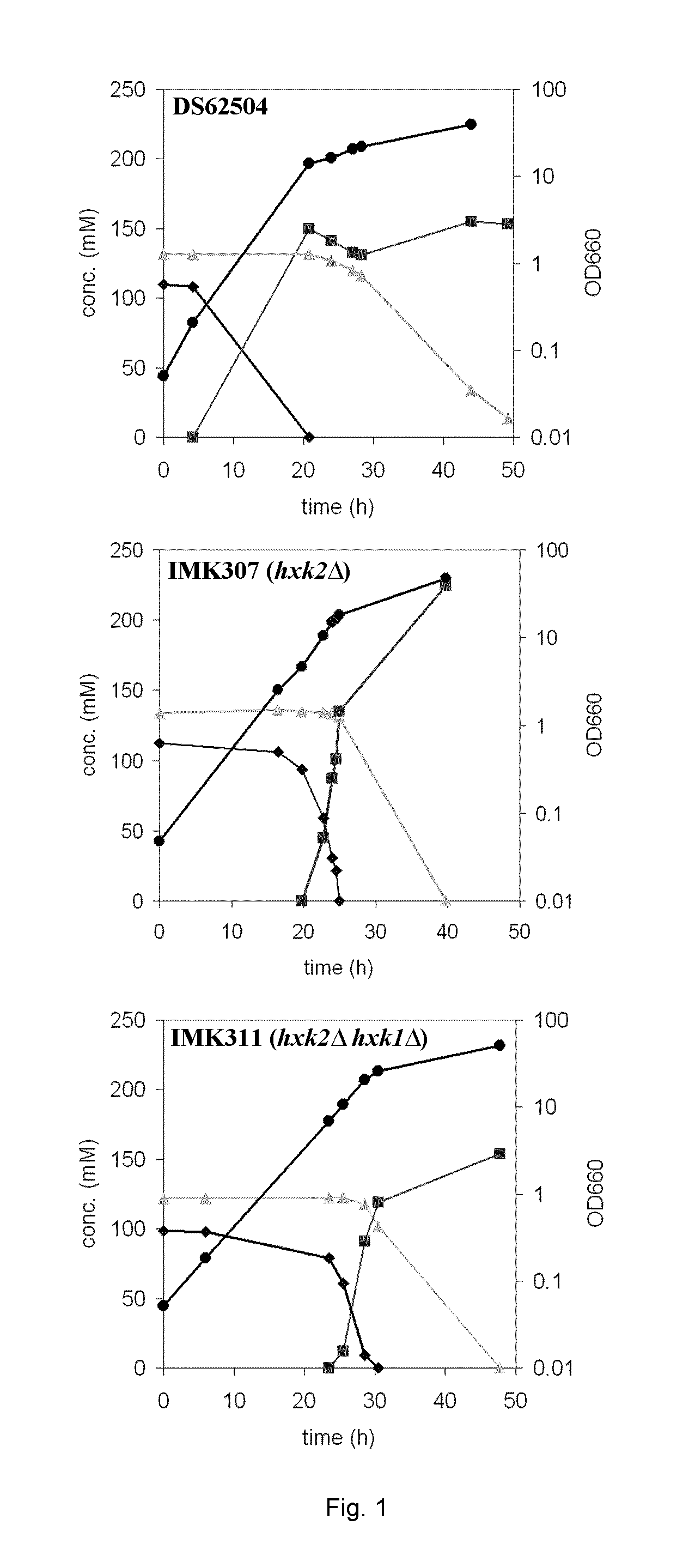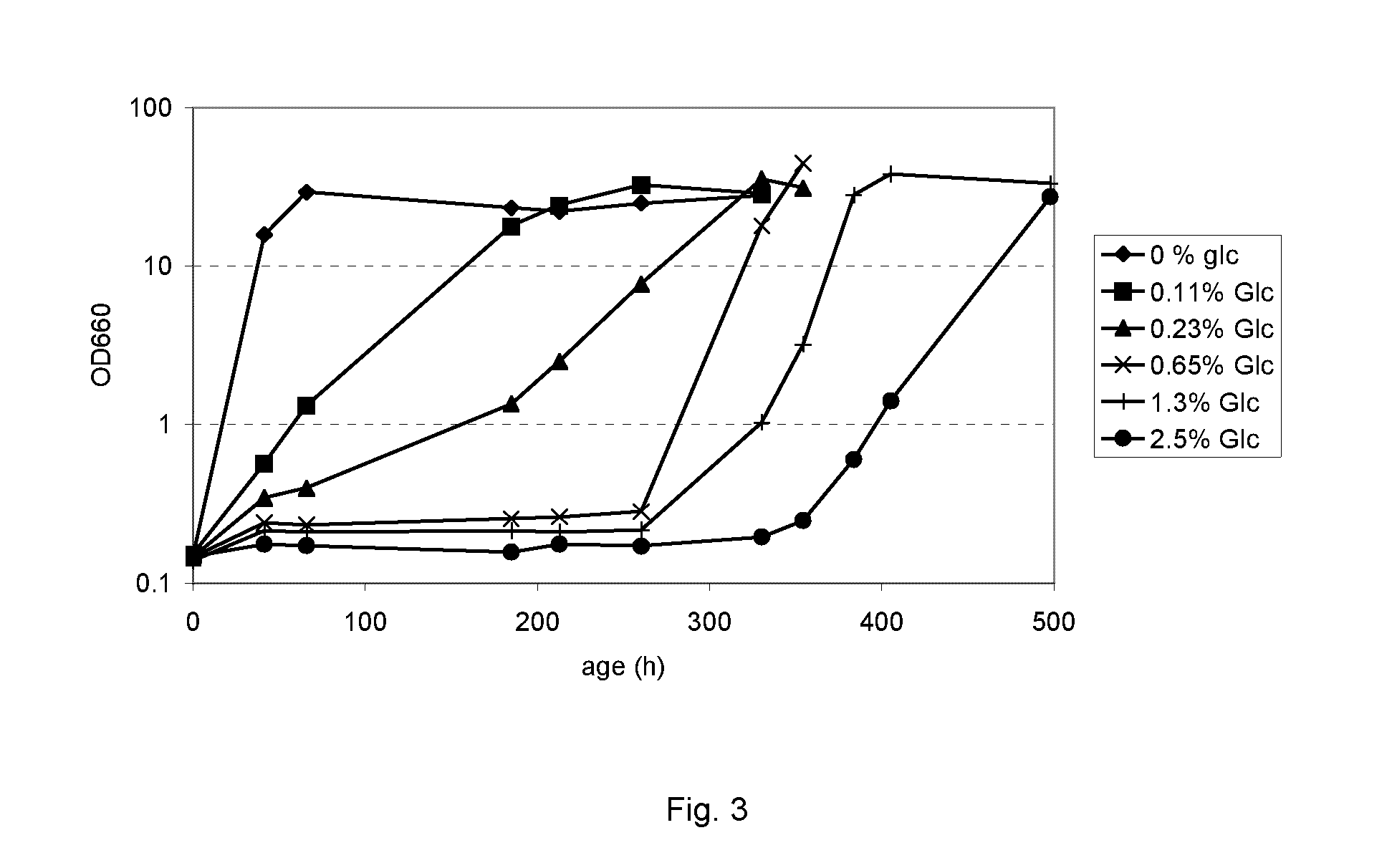Pentose and glucose fermenting yeast cell
a yeast cell and pentose technology, applied in the direction of lyase, transferase, peptides, etc., can solve the problems of low yield relative to fermentation rate, strains that rarely produce ethanol, and cannot utilize the five-carbon sugars contained in the hemicellulose component of biomass feedstocks, etc., to reduce the fermentation time of c5/c6 fermentation
- Summary
- Abstract
- Description
- Claims
- Application Information
AI Technical Summary
Benefits of technology
Problems solved by technology
Method used
Image
Examples
example 1
[0176]Gene Deletions.
[0177]Gene deletions herein were achieved by integration of a G418 resistance cassette replacing the target gene. For the deletion of HXK2, HXK1 and GLK1, the KanMX cassette from pUG6 was amplified by PCR [4], using oligonucleotides indicated in Table 2.
[0178]
TABLE 2Oligonucleotides used in this study for theconstruction of gene deletions and relateddiagnostic purposes. A KanMX gene deletioncassette was obtained by PCR by using combinationsof the DisA and DisB oligonucleotides. Genes weredisrupted by homologues recombination between thetarget gene and the KanMX gene deletion cassette.Recombination sites are indicated by the under-lined regions in the oligonucleotides. Deletion ordisruption was confirmed by PCR using diagnosticprimers KanA and KanB combined with the FW and theRV diagnostic primers corresponding with thetarget gene (e.g. KanA combined with HXK2-FW andKanB combined with HXK2-RV).Name5′-3′ DNA sequenceOligonucleotides used for construction of genedi...
example 2
[0186]Selection of IMK318 Growing on Arabinose in the Presence of Glucose.
[0187]It was confirmed by 450 hours of cultivation in shake flasks on glucose that the hexokinase / glucokinase deletion strain IMK318 (hxk1Δ hxk2Δ glk1Δ) is unable to grow on glucose alone. Therefore the strain was cultivated in YP-EtOH / Glyc and subsequently stored at −80° C. after the addition of glycerol. Subsequently, IMK318 was cultivated in 100 ml MY containing 2% arabinose. After 3 days, at an OD660 of approximately 1, 2 ml of the culture was transferred to 100 ml fresh MY containing 2% arabinose. After approximately 12 days the OD660 of the culture was >5 and samples were stored at −80° C. as glycerol stocks. Strain IMK318 was cultivated at 30° C. for several days in MY-ara. At an OD660 of approximately 5, 2 ml of the culture was transferred to 6 separate shake flasks containing 100 ml MYurea supplemented with 2% arabinose and varying concentrations of glucose: 0, 0.11, 0.23, 0.65, 1.3 and 2.5 (w / v) %. G...
example 3
[0192]Anaerobic Co-Fermentation of Arabinose and Glucose.
[0193]Strain IMW017 was cultivated anaerobically in a mixture of glucose and arabinose, using a sequential batch fermenter set-up. Three consecutive batches in the glucose / arabinose mixture were performed (FIG. 6). In each batch glucose and arabinose were consumed simultaneously and was fermented into ethanol. Deduced from the CO2 production profile, it was observed that the specific growth rate on the glucose / arabinose mixture increased from 0.05 h−1 in the first batch to 0.07 h−1 in the third batch.
[0194]During further consecutive batch fermentations, the growth rate is increased even further. A single colony isolate strain taken from the final batch, exhibits glucose and arabinose co-consumption at an increased specific consumption rates compared to IMW017.
PUM
| Property | Measurement | Unit |
|---|---|---|
| concentration | aaaaa | aaaaa |
| concentrations | aaaaa | aaaaa |
| temperature | aaaaa | aaaaa |
Abstract
Description
Claims
Application Information
 Login to view more
Login to view more - R&D Engineer
- R&D Manager
- IP Professional
- Industry Leading Data Capabilities
- Powerful AI technology
- Patent DNA Extraction
Browse by: Latest US Patents, China's latest patents, Technical Efficacy Thesaurus, Application Domain, Technology Topic.
© 2024 PatSnap. All rights reserved.Legal|Privacy policy|Modern Slavery Act Transparency Statement|Sitemap



